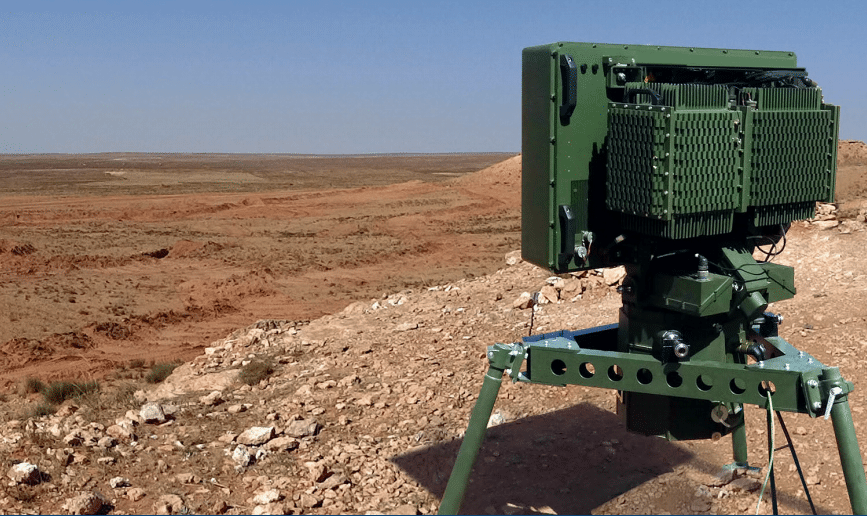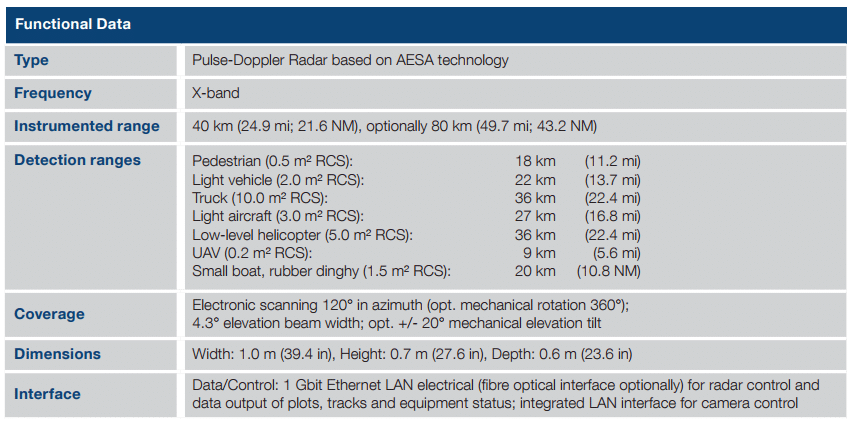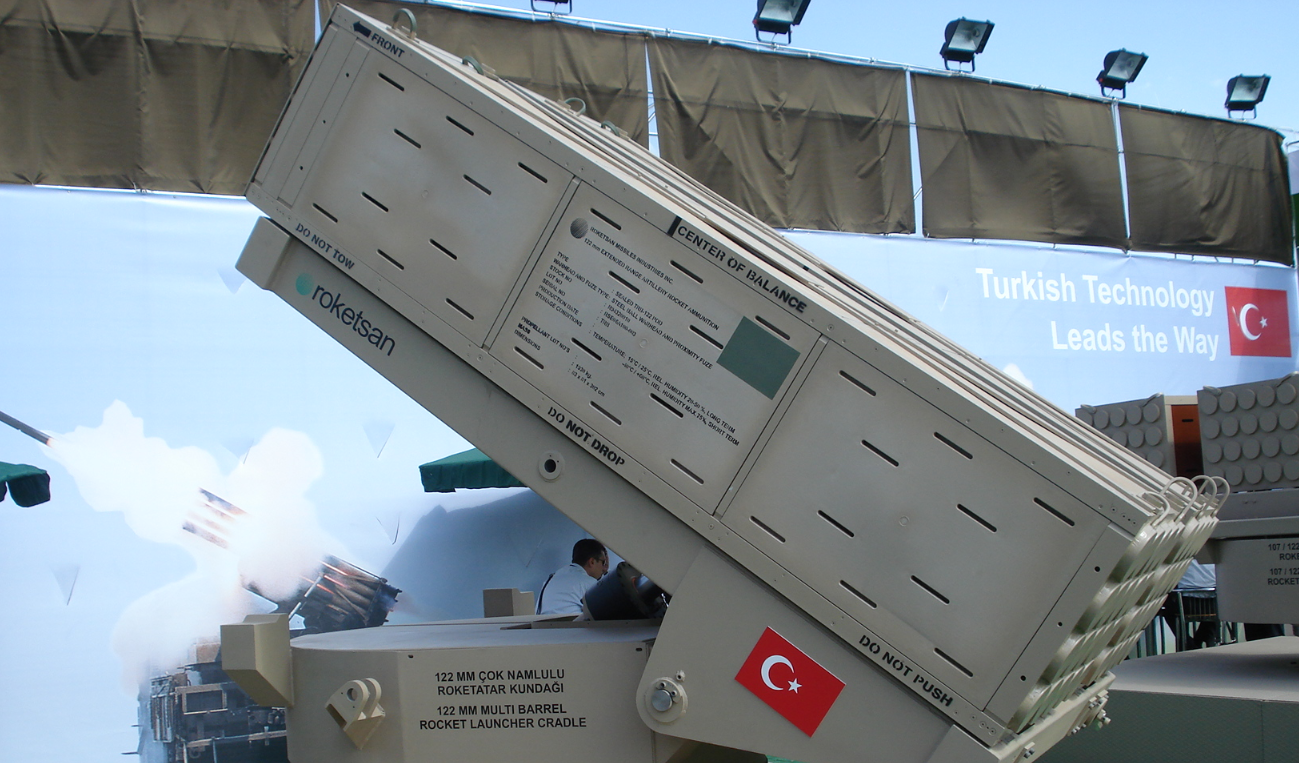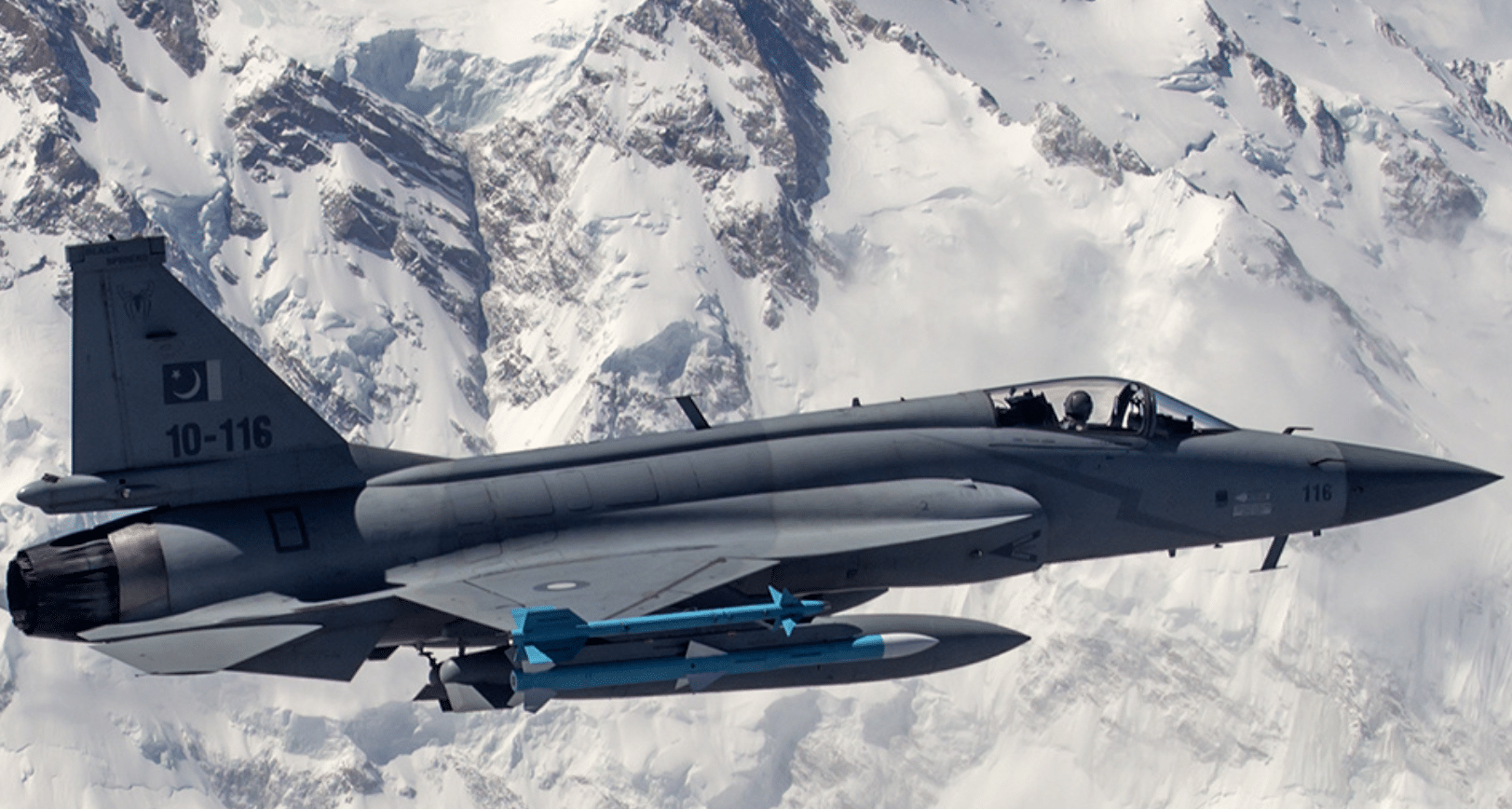2357Views 20Comments

Profile: Hensoldt Spexer 2000 Border Surveillance Radar
The German sensor and optronics company Hensoldt is pitching its Spexer 2000 Border Surveillance Radar as an intelligence, surveillance and reconnaissance (ISR) and situational awareness asset for countering asymmetrical threats. The Spexer 2000 is an X-band active electronically-scanned array (AESA) radar with an instrumented range of 40 km (with an optional variant capable of up to 80 km). (Note: for information on radar technology, including AESA radars, see Quwa’s background brief)
Although a short-range radar in its technical parameters, the Spexer 2000 is functionally designed to provide border security agencies (and militaries involved in border-policing) with the ability to detect and identify relevant entities – such as pedestrians, vehicles, unmanned aerial vehicles (UAV), low-flying helicopters, small aircraft and boats – at relatively comfortable ranges. In addition, Hensoldt says that the Spexer 2000 can track “extremely fast objects such as guided missiles.”
For example, the Spexer 2000 can detect a pedestrian – for which Hensoldt defines a radar cross-section (RCS) of 0.5 m2 – at up to 18 km. Light or small vehicles (2.0 m2 RCS), light aircraft (3.0 m2 RCS) and low-flying aircraft (5.0 m 22 RCS) can be detected at 22 km, 27 km and 36 km, respectively. UAVs as small as 0.2 m2 RCS can be detected at up to 9 km. At these distances, border agencies and armed forces entities may have adequate time to activate their response mechanisms for possible intrusions.
The Spexer 2000 can be deployed as a fixed system or as a transportable system (mounted on a truck). Hensoldt is also offering a variant for situational awareness in coastal areas – i.e. the Spexer 2000 Coastal. It can detect swimmers (0.1 m2 RCS), small boats (1.5 m2 RCS) and surface ships (of 100 m2 RCS) at 1 km, 20 km and 40 km, respectively. The Spexer 2000 Coastal retains the ground and air detection capabilities of the standard version, allowing for land, sea and air coverage.
Being an AESA radar, the Spexer 2000-series should possess strong defensibility against electronic warfare (EW) jamming. Hensoldt could basically position the Spexer 2000 as an asset for counterinsurgency and low-intensity threats from non-state and state-actors alike. In addition, the Spexer 2000 can offer another coverage layer beneath low-level air surveillance radars. Militaries could consider employing the Spexer 2000 with electro-optical and infrared systems, offering users a combined radar picture and visual feed.
In tests, Hensoldt was able to demonstrate the Spexer 2000’s capability of detecting the firing of a Milan anti-tank missile. Interestingly, the test was conducted with the Spexer 2000 stationed to the U.S. Navy destroyer the USS James E Williams, suggesting that the Spexer 2000 could be deployed as a ship radar. It is worth noting that Hensoldt also offers an AESA-based radar for offshore patrol vessels (OPV) and small surface combatants, i.e. Tactical Radar for Surface Surveillance (TRSS). The TRSS is an X-band radar with a range of over 40 km and capability to track more than 100 targets.
In May 2017, Hensoldt announced that it received orders for 50 radars from numerous customers in the Middle East and North Africa. The cumulative value of these orders is €40 million ($47.9 million U.S.). Thus far, Hensoldt has sold 150 Spexer 2000 radars with 1.7 million cumulative hours of usage.
Hensoldt was formed by the private equity group KKR using Airbus Defence and Space’s (Airbus DS) spun-off divisions: Airbus DS Electronics and Border Security GmbH and Airbus DS Optronics GmbH. Hensoldt inherited 4,000 employees in Europe and South Africa and annual revenue potential of over $1 billion. In July 2017, Hensoldt had agreed with ECI Partners to purchase the latter’s stake in British radar company Kelvin Hughes. Hensoldt’s breadth of activities position it as a competitor to Raytheon, Leonardo, Thales and Saab, among others, in radars, optronics, avionics, EW and countermeasures.
The following are the Hensoldt Spexer 2000’s specifications from the Hensoldt website (the Spexer 2000 Coastal’s specifications can also be found – link):




20 Comments
by Qasim57
Didn’t Pakistan come up with an indigenous ground radar solution some months ago? The specs (and price) definitely would not be close, but I wonder how they compare!
by Waleed Ahmad Qureshi
Very interesting. should be considered carefully
by umar rana
which company made it??????
by sami shahid
Interesting…. Pakistan should really buy such radars for the protection of its borders with Afghanistan & Iran. Hope Pakistan would really consider it.
by Asif Khan_47
yes, Pak Army uses it both at the LOC and Afghanistan border. It has a rang of 20km and it cuts through a lot of clutter.
by Bilal Khan
It was developed by NUST. I don’t know who actually manufactures it.
by Steve
Off topic. Do you see the fine given to Habib bank in New York. They are trying to do a BCCI on the bank. Economic war has started courtesy of a brainless Af plan by morons. Time to remove assets from USA before they are frozen, and embrace China/Russia even more closely.
by Abdul Rahim
No BCCI and HBL are two different issues. HBL is now owned by Agha Khan, who has a history of money laundering. https://youtu.be/F-cqtx5Kw5M
https://www.dawn.com/news/352230 http://www.akdn.org/press-release/habib-bank-akfed-pledges-strength-continuity-and-innovation
by MT
Habib bank case under FBI radar for fraudulent transaction and money laundering for politician and agency since 2006.
Fine may be bit high but many indian companies have been fined by bill $ by FDA and usa trade department for much trivial reason
by Uttam Singh
Yeah at the “cusp” of AESA development. Btw, what was the last AESA designed in house in Pakistan? Does Pakistan even has a dedicated Radar design and development agency like LRDE?
by Steve
https://www.dawn.com/news/1323372/local-university-develops-pakistans-first-phased-array-radar
by Steve
Some basic university research.
http://www.nust.edu.pk/Research/RnDProjects/Pages/ProjectsInProgress.aspx
please check out project 8.
by Steve
Google ‘cusp’ and educate yourself before shooting yourself in the foot. My statement is accurate.
by Steve
https://defence.pk/pdf/threads/pakistan-developed-radars-exported-to-jordan.463081/
There is plenty of stuff there to make you eat your words. I’m not educating an Indian any longer.
by Syed Arbab Shah
1. Is there any border fence and protection system equal to the one used by Israel and manufactured by ELBIT systems?
2. Can China help us in this regard?
by amar
Hi @disqus_1y2MoYiK2O:disqus
Did you yourself bother going through the defence.pk site that you provided as reference?
Let me instead provide you the university link-
http://nust.edu.pk/Research/RnDProjects/Pages/Completed-Research-Projects.aspx
Now use ‘ctrl’+’f’ and type radar.
This will clearly tell you that Pakistan is in very very crude and infant stage in any kind of radar related development let alone AESA! The only radar “productionized” to a limited extend is the ground surveillance radar. And the Phased array radar they are talking about is actually fed by “horn” or waveguides! And I hope you’re educated enough to know what kind of phased array is fed by horn waveguide!
To be brutally honest, radar related research in Pakistan is pretty much limited to some university research as of now. The matter of fact is, Pakistan woefully lacks a dedicated radar design and development lab and industry to back it up.
by Steve
I said we are at the ‘cusp’ of development… never said deployed. It has been identified as one area in the new Aerospace development. Stop being argumentative and splitting hairs. India builds no AESA as well, so don’t send hundreds of links of dreams and aspirations.
by amar
Yeah exactly India doesn’t build an AESA–wish you had done a little bit of your research. No wonder pakistan produces top notch academicians and researchers(either in Pakistan or working abroad). Is it because you deliberately choose to ignore in order to avoid frustration at the fact that Pakistan is no where near India in radar related research or your incompetency speaking here?
Especially when India is a zillion times more transparent about her defence program vis a vis Pakistan. Don’t worry, I’ll help you out– open Google and search–LSTAR,ASHWINI,ARUDHRA,UTTAM to speak of.
While lstar has already been inducted into IAF, ASHWINI and Arudhra are entering small scale production. And no they are not israeli, in case you wish to discuss the patents etc, I’d be more than willing to oblige, but I’m afraid you won’t be able to make any of it.
by jigsaw
Hi, let this be clear once and for all. The real Pakistani research and development never takes place in the universities, because those entities are largely funded by gov and the govs do not provide enough funds for R&D but are more into corrupt practises – hence they will never produce expected results, and as Pakistanis we have no problem in accepting that. NUST however, is a top notch university and somewhat an exception along with some other universities, but where the real stuff is getting made are places you will never hear in media or find through internet. Any avid observer will know that Pakistan’s defence and military programs are highly shrouded in secrecy for all the known reasons because as i’ve explained before, they’re result oriented programs and not technology demonstrator lab projects – which most of Indian programs are. I do not want to name any specific organizations here but the Pakistani military carries out research in every field they have interest in from nuclear technology, to missiles, to aviation tech and more, but is never openly advertised nor acknowledged. If heavy reporting in the media is your sole criteria of transparency of Indian projects, let this be re-said that it’s done for one reason: boasting. And i’ve said this a number of times, since military projects in Pakistan are overseen by the military, there is neither time nor else to boast about them openly in media. You have your transparency which ends up india being largest importer of weaponry in the world, and pakistan has its non-transparency or secrecy which ends up producing functional result oriented systems, without boast or brag in it. I’m not sure if Pakistan is researching AESA or not, but if and when PAC will decide to do it, rest assured it won’t be a lab project but something you’ll actually see on a JF-17 like program.
Keep that in mind always when commenting on pakistani defence research.
by amar
First of all, thanks for taking time to write something you have no idea about. Let me ask you something first, what are your credentials or experience in research? Mean while you answer that question, let me answer your random hot air one by one(and btw before you write me off as someone who doesnt know about things like this, let me just say that I have got research paper in presetigious AIAA(American Institute of Aeronautics and Astronautics) in the field of thrust vectoring and nonlinear control).
1) NUST hardly makes it to list of top 500 univs in QS ranking(this year it has been ranked in 450-500). Whereas, first 5 IITs in India are ranked below 200. Not only that, since you have so many IITians as faculty and in senior positions in various top american univs, they have not only joint research collaboration and joint doctoral program with IITs. In fact for an IIT under grad getting into any decent American univ is a much simpler affair compared to someone from lets say NUST.
2) If you care to go through various American reports or reports published outside Pakistan, you would find out that the Pakistani labs you never heard of, actually assembles Chinese designed engineering products. And since either India or Pakistan isnt into designing something so advanced that it has never been attempted before, the other side wont really gain a decisive advantage by knowing if the other is working on a particular technology. For instance most of the technology of lets say cruise missile is already known or have been mastered in west, and India and Pakistan just have to “engineer” the cruise missile. The problem comes while designing the sub-systems and integrating various such sub-systems into a working product.
3) And no my friend, Indian research programs are not “transparent” because a lot of details are available in media, they are transparent because each success and failure is accounted for and released to public for broader scrutiny–something entire unheard of in Pakistan. Also the CAG(there is really no equivalent of CAG in Pakistan!) lays open all the deficiencies and shortcomings of each and every aspect of Govt dept “including” MoD. And unlike, Pakistan, CAG reports are debated in Parliament. The harsh criticism of various time overruns and cost overruns in various defence projects in India can be attributed to CAG as it published all the “bad” things about the way we dept work in India. When was the last time you heard any such “audit report” flaking any Pakistani military program? Kindly spare me the pain that Pakistani research is ahead of India’s and that they “mysteriously” get things done in the very first time!
4) And lastly do you have any idea where both India and Pakistan stands vis-a-vis each other in research. In case you “deliberately” ignored it till now, I would suggest you to open “scimago” and look for yourself.